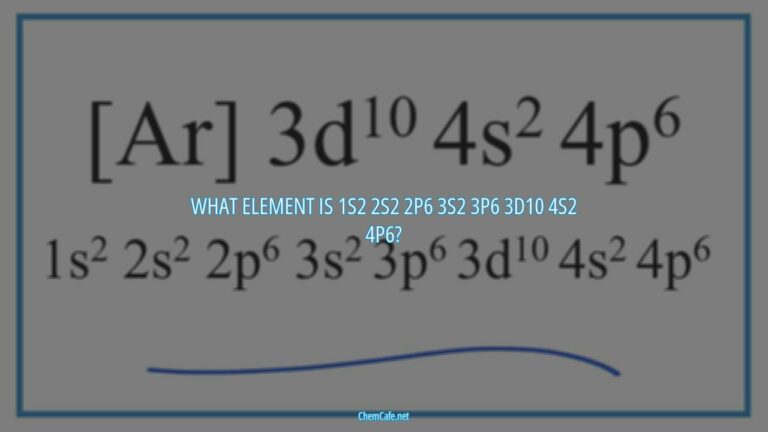The electronic configuration of elements is an important concept to understand when studying the periodic table. An electronic configuration is a symbolic representation of how electrons are distributed across the energy levels of an atom. It is represented by the row number of the element, the block letter and the number of electrons present in the orbital written in superscript.
For example, the electronic configuration of carbon (atomic number: 6) is 1s22s22p2. This indicates that the element Carbon has two electrons in the first energy level, two in the second energy level, and two in the third energy level. To understand the electronic configuration of elements, there are three important rules that must be followed.
The first rule is to start at the top of the periodic table and move from left to right across the rows. This will give you the row number, the block letter and the number of electrons that are in each block’s section. The second rule is to always write the energy level and the type of orbital first, followed by the number of electrons present in the orbital written in superscript. The third rule is to pay attention to the exceptions in the periodic table. Some elements have an extra electron in a higher energy level than the others. For example, the electron configuration of Copper (atomic number: 29) is 1s22s22p63s23p64s23d10. This is due to the presence of an extra electron in the fourth energy level.
Therefore, when looking at the electronic configuration 1s² 2s² 2p5 3s¹, it indicates that the element has two electrons in the first energy level, two in the second energy level, five in the third energy level and one in the fourth energy level.
An understanding of electronic configurations is essential to comprehending the periodic table. To learn more about this topic and other related topics, such as Lewis dot structures, register with BYJU’S and download the mobile application on your smartphone.
What does the electronic configuration 1s² 2s² 2p5 3s¹ indicate?
The electronic configuration 1s² 2s² 2p5 3s¹ is a representation of the distribution of electrons in the orbitals of an atom. This notation is used to understand the structure of an atom and the way it interacts with other atoms.
Electronic configurations are written using a standardized notation, which is composed of the energy level, the type of orbital and the number of electrons present in the orbital written in superscript. In the example 1s² 2s² 2p5 3s¹, the energy level is represented by the numerical value of the orbital, the type of orbital is indicated by the letter (s, p, d, f) and the number of electrons is indicated by the superscript.
For example, the electronic configuration 1s² 2s² 2p5 3s¹ indicates that the atom has two electrons in the 1s orbital, two electrons in the 2s orbital, five electrons in the 2p orbital and one electron in the 3s orbital.
Rules for Writing Electronic Configurations
There are three rules that must be followed while writing the electronic configuration of elements:
Rule 1: The orbitals fill in order of increasing energy. This means that the lowest energy orbital (1s) will fill first, followed by the 2s, 2p, 3s, 3p, 4s, 3d, 4p, 5s, 4d, 5p, 6s, 4f, 5d, 6p, 7s, 5f, 6d and 7p orbitals.
Rule 2: Each orbital can only contain a maximum of two electrons. This means that only two electrons can occupy an orbital, regardless of how many electrons the atom has.
Rule 3: Electrons must obey the Pauli exclusion principle. This means that no two electrons can occupy the same orbital and that electrons must have opposite spins (the sum of the spins must be zero).
So, the electronic configuration 1s² 2s² 2p5 3s¹ indicates that there are two electrons in the 1s orbital, two electrons in the 2s orbital, five electrons in the 2p orbital and one electron in the 3s orbital. The configuration also indicates that the electrons have opposite spins, as required by the Pauli exclusion principle.
Understanding Electronic Configurations
Understanding electronic configurations can help us understand the structure and behavior of atoms. For example, understanding the electronic configuration of carbon (1s² 2s² 2p2) can help us understand why carbon forms four bonds with other atoms. This is because the 2p orbital of carbon contains four electrons, which can be used to form four covalent bonds with other atoms.
In addition, understanding electronic configurations can help us understand the properties of elements. For example, knowing the electronic configuration of sodium (1s² 2s² 2p⁶ 3s¹) can help us understand why sodium is a good conductor of electricity. This is because the 3s orbital of sodium contains one electron, which can easily move from one atom to another, allowing electricity to flow.
Understanding electronic configurations can also help us understand the reactivity of elements. For example, understanding the electronic configuration of chlorine (1s² 2s² 2p⁶ 3s² 3p⁵) can help us understand why chlorine is a very reactive element. This is because the 3p orbital of chlorine contains five electrons, which can easily be removed or added to form bonds with other atoms.
To learn more about electronic configurations, the structure and behavior of atoms, and the properties of elements, register with BYJU’S and download the mobile application on your smartphone.
What does the electronic configuration 1s 2 2s 2 2p 5 3s 1 indicate?
The electronic configuration 1s 2 2s 2 2p 5 3s 1 is a way of writing the arrangement of electrons in an atom. It follows the Aufbau, Pauli, and Hund’s rules, which dictate how electrons fill the atomic orbitals of an atom. This particular electronic configuration indicates that the atom has two electrons in the 1s shell, two electrons in the 2s shell, five electrons in the 2p shell, and one electron in the 3s shell.
Aufbau Principle
The Aufbau Principle states that electrons fill atomic orbitals in order of increasing energy. This means that electrons first fill the 1s orbital, then the 2s orbital, and then the 2p orbital of an atom. This electronic configuration follows this rule, as it goes from the 1s orbital to the 2s orbital to the 2p orbital and then to the 3s orbital.
Pauli Exclusion Principle
The Pauli Exclusion Principle states that no two electrons in an atom can have the same set of four quantum numbers. This means that no two electrons in the same atom can have the same energy, angular momentum, spin, and orbital. This electronic configuration follows this rule, as only two electrons can occupy the same orbital with opposite spins.
Hund’s Rule
Hund’s Rule states that electrons occupy orbitals of equal energy singly before they pair up. This means that in an orbital with more than one electron, the electrons will fill the orbital singly before they pair up with another electron. This electronic configuration follows this rule, as the 2p orbital has five electrons and they are all single and unpaired.
The electronic configuration 1s 2 2s 2 2p 5 3s 1 indicates that the atom has two electrons in the 1s shell, two electrons in the 2s shell, five electrons in the 2p shell, and one electron in the 3s shell. This electronic configuration follows the Aufbau, Pauli, and Hund’s rules, which dictate how electrons fill the atomic orbitals of an atom. As such, it is a correct way of writing the arrangement of electrons in an atom.
What does the electronic configuration 1s2 2s2 2p6 3s2 3p4 represent?
The electronic configuration 1s2 2s2 2p6 3s2 3p4 represents the arrangement of electrons in an atom. It is important to understand the structure of an atom and the organization of its electrons in order to understand chemistry. In this article, we will discuss the meaning of the electronic configuration 1s2 2s2 2p6 3s2 3p4 and the rules for writing electronic configurations.
What is the Electronic Configuration?
The electronic configuration of an atom describes the arrangement of electrons in its orbitals. Electrons are arranged in shells or energy levels and orbitals around the nucleus of an atom. The electrons occupy the lowest energy level first and the higher energy levels later on. The electronic configuration of an atom is written in a standard notation, which consists of the energy level and the type of orbital followed by the number of electrons present in the orbital written in superscript.
For example, the electronic configuration of carbon (atomic number: 6) is 1s22s22p2. This indicates that the carbon atom has two electrons in the 1s orbital, two electrons in the 2s orbital and two electrons in the 2p orbital.
What does the Electronic Configuration 1s2 2s2 2p6 3s2 3p4 Represent?
The electronic configuration 1s2 2s2 2p6 3s2 3p4 represents the arrangement of electrons in the calcium atom. Calcium is a chemical element with atomic number 20, which means it has 20 electrons. In this configuration, all the 4p orbitals are empty, which means that the last two electrons have to be removed from the 4s orbital. Therefore, the electronic configuration of calcium is 1s2 2s2 2p6 3s2 3p6 4s2.
Rules For Writing Electronic Configurations
When writing the electronic configuration of an atom, there are three important rules to follow:
- Aufbau Principle: This principle states that electrons are added to the orbitals in order of increasing energy. This means that the lowest energy level should be filled first and the higher energy levels should be filled later on.
- Pauli Exclusion Principle: According to this principle, no two electrons can occupy the same orbital. This means that each orbital can only contain two electrons with opposite spins.
- Hund’s Rule: This rule states that when orbitals of the same energy level are being filled, the electrons should occupy them in such a way that the number of electrons with the same spin is maximized.
In conclusion, the electronic configuration 1s2 2s2 2p6 3s2 3p4 represents the arrangement of electrons in the calcium atom. The electrons are arranged according to the Aufbau Principle, the Pauli Exclusion Principle and Hund’s Rule. By understanding the electronic configuration of atoms, we can gain insight into the structure and properties of an atom.
Which electron configuration indicates a transition element?
Transition elements are a group of elements found in the d-block of the periodic table. The unique chemical properties of these elements are largely due to their electron configurations, which can vary from element to element. In order to determine which electron configuration indicates a transition element, it is important to understand the aufbau principle and the relative energies of the orbitals.
The Aufbau Principle
The aufbau principle states that electrons fill the lowest-energy atomic orbitals before they can fill the higher-energy atomic orbitals. This means that when filling the orbitals of an atom, electrons will always fill the orbitals of an atom in order of increasing energy. For example, the 4s orbital will always fill before the 3d orbital because it has the lower energy value.
The Relative Energies of Orbitals
The relative energies of orbitals can be determined by looking at their row number on the periodic table. For first row transition metals, the electron configuration would simply be [Ar] 4sx3dx. However, there is an exception for the d-block and f-block elements, in which the energy level of the d-block is “n-1” and the energy level of the f-block is “n-2”.
Electron Configurations of Transition Elements
The electron configurations of transition elements will vary depending on their position in the d-block and f-block. For example, the period four transition metal elements have the simplest electron configurations of all the different types of transition metals. These elements have electron configurations of [Ar] 4s23d10. This electron configuration indicates that these elements have two electrons in the 4s orbital and ten electrons in the 3d orbital, which is indicative of a transition element.
In conclusion, electron configurations that contain two electrons in the 4s orbital and ten electrons in the 3d orbital indicate a transition element. This is because these elements have the highest energy level of all the first row transition metals, which is indicative of a transition element. Understanding the aufbau principle and the relative energies of orbitals is key to determining which electron configuration indicates a transition element.
What is the electronic configuration of 1s2 2s2 2p6 3s2 3p4?
Electronic configuration is a method of depicting the arrangement of electrons around an atom’s nucleus using the periodic table. An atom’s electronic configuration is an important factor in determining its chemical and physical properties. The electronic configuration of 1s2 2s2 2p6 3s2 3p4 is the atomic structure for oxygen, a non-metal element.
The electronic configuration of an atom is determined by the number of protons present in the nucleus. The number of electrons in an atom is equal to the number of protons and is determined by the atomic number of the element. The orbital structure of an atom is determined by the number of electrons and the energy levels at which they are found.
Three Rules for Writing Electronic Configurations
There are three rules that must be followed when writing the electronic configuration of an element. The first rule is to write the energy level (n) and the type of orbital (l) first. This is followed by the number of electrons present in the orbital written in superscript. The second rule is to fill each orbital with electrons before moving to the next higher energy level. The third rule is to fill the orbitals of the same energy level in order of increasing angular momentum.
The Aufbau Principle
The Aufbau Principle is based on the energy levels of orbitals and the number of electrons they can hold. It states that electrons fill orbitals in order of increasing energy level, starting with the lowest energy level first. This means that the 1s orbital is filled first, followed by the 2s and 2p orbitals, and so on.
The Pauli Exclusion Principle
The Pauli Exclusion Principle states that no two electrons can occupy the same orbital. This means that each orbital can only hold a maximum of two electrons, and these electrons must have opposite spins. When all the orbitals of a given energy level have been filled, the electrons start to fill the next higher energy level.
Hund’s Rule
Hund’s Rule states that when orbitals of the same energy level are being filled, the electrons will fill them one at a time with the same spin. This means that the orbitals will be half-filled before the electrons start pairing up with opposite spins.
To summarize, the electronic configuration of 1s2 2s2 2p6 3s2 3p4 is the atomic structure for oxygen, a non-metal element. This configuration is determined by the number of protons present in the nucleus, and is written following the three rules of writing electronic configurations. The Aufbau Principle states that electrons fill orbitals in order of increasing energy level, while the Pauli Exclusion Principle states that no two electrons can occupy the same orbital. Finally, Hund’s Rule states that when orbitals of the same energy level are being filled, the electrons will fill them one at a time with the same spin.
What is the element with an electron configuration of 1s22s22p63s23p1?
Electron configurations are used to explain the arrangement of electrons in an atom. The electron configuration of an element describes how electrons are distributed in its atomic orbitals. It is written in a standard notation that includes the number of electrons contained in each atomic subshell.
Table of Content
- Filling of Atomic Orbitals
- Aufbau Principle
When trying to determine the element with an electron configuration of 1s22s22p63s23p1, it is important to understand how the electron configuration is written and why it is important. This article will explain what an electron configuration is, how it is written, and how to use it to identify elements.
Filling of Atomic Orbitals
Atomic orbitals are regions in an atom where electrons are most likely to be found. The filling of atomic orbitals follows the Aufbau Principle, which states that electrons will occupy orbitals with lower energy levels before occupying higher energy levels. This is why the electron configuration of an atom is written in a specific order.
The electron configuration of an element is written with a series of superscripts that indicate the number of electrons in each atomic orbital. For example, the electron configuration of magnesium (atomic number 12) is written as 1s2 2s2 2p6 3s2. This means that the 1s orbital has two electrons, the 2s orbital has two electrons, the 2p orbital has six electrons, and the 3s orbital has two electrons.
Aufbau Principle
The Aufbau Principle is named after the German word ‘Aufbau’ which means ‘build up’. This principle dictates that electrons will occupy the orbitals having lower energies before occupying higher energy orbitals. The energy of an orbital is calculated by the sum of the principal and the azimuthal quantum numbers.
In order to identify the element with an electron configuration of 1s22s22p63s23p1, you first need to add up the number of electrons contained in each orbital. The supercripts (2, 2, 6, 2 and 2) are the number of electrons in each orbital. Simply add up these numbers, which will give you 14. Now just look for the element on the periodic table with the atomic number of 14.
The element with an electron configuration of 1s22s22p63s23p1 is Silicon (Si). This element is located in the 14th column of the periodic table and is a semi-metal. Silicon is a very important element in the modern world and is used in many applications such as semiconductors and solar cells.
In conclusion, electron configurations are an important tool for understanding the arrangement of electrons in an atom. By adding up the number of electrons contained in each orbital, it is possible to identify the element with an electron configuration of 1s22s22p63s23p1 as Silicon (Si). This element is important for many modern applications and is found in the 14th column of the periodic table.





Leave a Comment